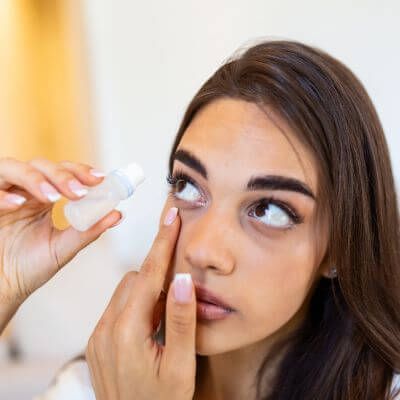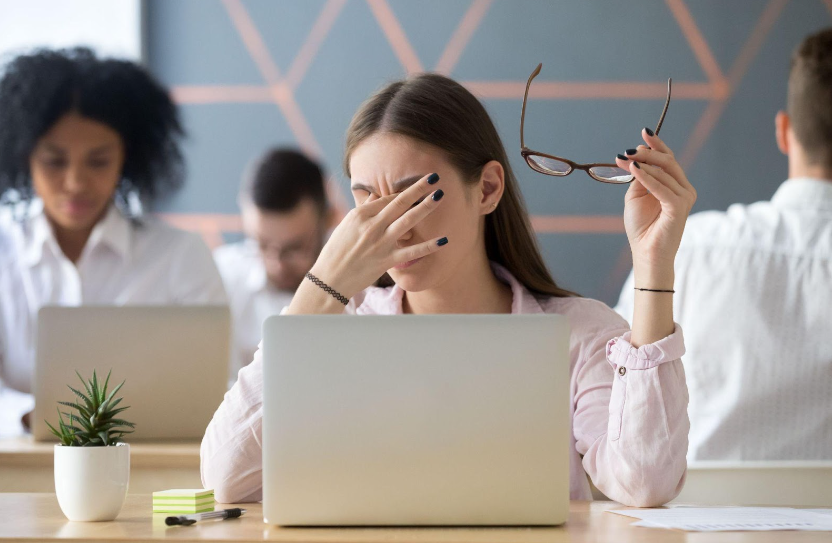Eye Health and Technology — Is Blue Light Dangerous for Eyes?
Digital screens are a mainstay of daily life. Unfortunately, spending too much time looking at them can cause your eyes to feel uncomfortable and tired. This has many people wondering if staring at screens all day could actually be bad for their eye health. Fortunately, while digital displays may irritate your eyes, they aren’t powerful enough to harm your vision.
Irritation from digital screens is caused by blue light. While not dangerous to your eyes, it can make them uncomfortable in a number of ways including making them feel dry and itchy. Eye strain can be greatly reduced or even prevented by following tips such as getting a comprehensive eye exam or using the 20-20-20 rule. “Computer glasses” are available that claim to block blue light, but research doesn’t support their effectiveness.
Why Are People Concerned About Eye Health and Technology?
Having a healthy work-life balance is always a struggle, but it’s become even more difficult over the past couple of years as COVID-19 has made working from home a necessity for many. While this has benefits such as less time spent commuting and more time spent with loved ones, it also makes it harder to escape the digital screens that consume our daily lives.
This had led many people to question whether all this screen time could be bad for their eyesight. The drive to and from work was a built-in buffer for your eyes. They gave your vision a break in between staring at your work computer screen all day until you got home to watch your TV all evening (in between checking your phone).
But now that buffer is gone and people are noticing.
Digital devices were already a big part of our lives, but working from home has turned them into a problem. Now there are few, if any, breaks during people’s screen time, causing them to have:
- Eyes that feel tired or strained
- More headaches
- Trouble sleeping
These discomforts have led some people to suspect that blue light is the source of their newfound eye problems.
What Is Blue Light?

According to Harvard Health Publishing , “Blue light is visible light with a wave length between 400 and 450 nanometers (nm).” Its wavelength is what causes us to perceive it as blue, although it can be present in white light, or any other color for that matter.
What makes blue light so concerning for some is that it has “more energy per photon of light than other colors in the visible spectrum” such as red and green. This means that the cells in your body are more likely to be harmed by blue light if absorbed in high enough doses.
Knowing this, it’s easy to understand why people worry about prolonged use of digital screens affecting their vision. After all, blue light is also known as blue LED light or short-wavelength LED ligh t, and LEDs (light-emitting diodes) are a core component of digital screens. It’s also almost impossible to tell the difference between blue light and natural light, making the situation even more concerning.
Is Blue Light Dangerous for Eyes?
This leads us to the big question: are digital screens dangerous for your eyesight?
The short answer is no . This is thanks to the fact that manufacturers have designed the LEDs to produce much more narrow peaks of light than, say, the sun. This is also why blue light can be hard to distinguish from white light or even daylight. In fact, it can even be used to mimic other sources of light without anyone noticing.
It is true that LEDs have the ability to produce more blue light than other light sources, even without it being noticed by users. However, it’s less than likely to pose any real danger to your eyes. While termed “blue light,” it’s actually the white LEDs in your digital devices that produce the most blue light, although it’s still less than natural light sources.
For context, recent iPhones produce a maximum brightness of about 625 candelas per square meter. Compare this to the average retail store where the fluorescent lights create about twice as much ambient illumination. Now consider the sun which emits 10 times the amount of ambient illumination as an iPhone.

Some sources of blue light are much stronger than what’s emitted from electronic screens. In these cases, high-intensity blue light is filtered or shielded to protect consumers from harm. But LEDs can still be powerful, so it’s just as unwise to look directly into high-powered flashlights as it is to look directly into an incandescent light source.
But screens for consumer electronics have nowhere near the brightness of high-powered devices that emit blue light. You’re at much greater risk for blindness and eye diseases due to factors such as:
- Smoking
- Cardiovascular disease
- Aging
- Obesity
- High blood pressure
When compared to these, the threat of blue light from consumer electronics on your vision is negligible at worst.
Digital Eye Strain: The Real Problem
Digital eye strain is a group of problems that can cause discomfort the longer you look at digital screens. It can cause your eyes to become:
- Itchy
- Watery
- Red
- Dry
Your eyes may feel uncomfortable or tired as the day progresses, which can affect your ability to focus.
While digital eye strain has been a problem over the past few decades , COVID-19 has made it much worse. Digital screens were already present in our lives due to computer monitors, TVs, smartphones, and tablets. However, working from home can cause you to jump from screen to screen with no breaks, increasing your discomfort. It’s been noted in adults as well as children.
Click here to learn more about eye fatigue!
What Causes Digital Eye Strain?

Reading text on a digital screen is usually much more difficult than on a printed page. This is why you may be able to read a physical book for longer than on a digital screen before your eyes become tired.
Eye strain from digital screens happens for a few reasons, including:
- Glare from the screen
- Poor lighting in your work area
- Poor posture while using digital devices
- Using the wrong distance and angle to view the screen
- Unaddressed vision problems
- Not blinking when viewing digital screens
- A combination of all of these factors
Another important factor is dry eye , which can make digital eye strain worse or more likely to occur. Dry eye is more common in adults over the age of 50 and is twice as common in women than in men.
Dry eye can also be made worse by certain health conditions and medications. One example is seasonal allergies, which can cause your eyes to become more dry than usual. Ironically, the antihistamines used for allergies can also cause dry eye. Other health conditions that can make your eyes drier than usual include thyroid disease and certain autoimmune diseases.
Click here to read our resources on dealing with dry eye.
Symptoms of Digital Eye Strain
Digital eye strain symptoms can vary from person to person, but there are some common signs to look out for. They include:
- Blurry vision
- Double-vision
- Dry eye
- Eyes that feel uncomfortable
- Eyes that feel tired
- Itchiness
- Redness
- Watery eyes
- Headaches
- Shoulder and neck pain
Fortunately, most of these symptoms are temporary and will go away once you’ve stopped using your device. Others can be addressed while using your computer, such as shoulder and neck pain.
Should and neck pain is usually a result of poor posture or alignment while working and can be fixed while using your device. Make sure you are sitting straight with both feet on the ground and your laptop elevated so that it is eye level. Sitting with the correct posture is the best way to reduce your shoulder and neck pain.
On the other hand, it is possible to feel the effects of digital eye strain for prolonged periods. This is usually due to using your device for too long without a break or having an underlying eye problem. Symptoms can become worse if they’re not addressed, so it’s important to address these issues as soon as possible.
Preventing Digital Eye Strain
While it’s unlikely that our need for digital screens will go away, there are steps you can take to protect your eyes from digital eye strain. By following these steps, you’ll greatly reduce the discomfort you experience from staring at screens for too long. This can help you stay focused at work as well as help you enjoy your free time more.
Get a Comprehensive Eye Exam

Also known as dilated eye exams , comprehensive eye exams are about more than updating your eyewear prescription. They allow our eye surgeons to view the structures of your eyes more closely to check for any problems. This is especially important since many eye diseases and other vision problems don’t show symptoms in the early stages.
This can also help when it comes to digital eye strain. Undiagnosed or uncorrected vision problems can actually cause you to strain your eyes even more. Issues such as nearsightedness , farsightedness , astigmatism , and presbyopia can all contribute to your case of digital eye strain. As Zhong-Lin Lu points out in the Washington Post :
If uncorrected, myopia [nearsightedness] (or its cousin, farsightedness) can contribute to another eye problem directly related to screen time: computer vision syndrome, also known as digital eyestrain, marked by blurred vision, dry eyes and neck and shoulder pain. The more time you spend reading on a screen, the more at risk you are.
With a comprehensive eye exam, our team can check for any underlying eye problems that may be contributing to your digital eye strain. They also allow us to check for other eye issues that can impact your vision, making them as necessary as your annual physical exam.
To learn more about the importance of dilated eye exams, read The Real Reason You Should Schedule A Dilated Eye Exam !
Follow the 20-20-20 Rule
The 20-20-20 rule is one of the best tricks for preventing digital eye strain. It works by making you look up from your screen, allowing your eyes to relax. Designed by optometrist Jeffrey Anshel in California, it provides an excellent reason to look away from your screen and enjoy the world around you.
The 20-20-20 rule is simple. All you have to do is:
- Every 20 minutes
- Look at something that’s 20 feet away
- For 20 seconds
It’s that easy!

Following these steps relaxes the muscles of your eyes and helps reduce strain. It can take some time to get in the habit, but the rewards are well worth it. You can turn the 20-20-20 rule into a habit by setting an alarm every 20 minutes while working as a reminder. Alternatively, special apps are available for download to help incorporate it into your daily routine.
And don’t forget to blink. Blinking promotes tear production which helps lubricate and soothe your eyes throughout the day. One of the reasons your eyes feel dry and uncomfortable after looking at a screen for a long time is because you forget to blink while concentrating.
The 20-20-20 rule is also helpful if you experience neck and shoulder soreness due to digital eye strain. Use your 20-minute breaks to get up, stretch, and walk around . This will help prevent soreness and remain comfortable throughout the day.
There hasn’t been a lot of research to test the effectiveness of the 20-20-20 rule. However, a 2013 study found that those who practiced the rule experienced fewer symptoms of digital eye strain, including eyes that are tired, watery, blurry, or dry. This has been enough for the American Academy of Ophthalmology and the American Optometric Association to recommend the 20-20-20 rule in the fight against digital eye strain.
Use Proper Lighting
Digital eye strain can also be made worse with bad lighting in your workspace. Extremely bright lights from bulbs or the outdoors can make interior light harsh and strain your eyes as well. In fact, the ideal ambient lighting is about half of what is found in most offices.
Close drapes, shades, or blinds to cut down on excessive exterior lighting. To reduce interior lighting, use fewer fluorescent tubes or light bulbs. You can also switch to tubes and bulbs with lower intensity for more comfortable lighting.
The position of your computer and desk are also important. You should face your screen so that windows are to the side of you rather than in front or behind it. To avoid excessive overhead lighting, move your desk out from under any fluorescent lights and switch to “soft white” LED floor lamps.
You can also try replacing your current interior lighting with “full-spectrum” fluorescent lights. They replicate the light emitted by the sun, which can be more comfortable than traditional lights for working on the computer. However, these lights can still be uncomfortable if they’re too bright.
You can also minimize glare with an anti-glare screen. This cuts down on light being reflected off your computer screen, as well as cuts down on reflections that can contribute to digital eye strain.
Adjust Your Display Settings
You can reduce or even prevent eye fatigue by adjusting your screen display settings to a comfortable level. Here are some tips for adjusting the settings to offset digital eye strain while you work.
- Brightness: Set the brightness of your screen so that it’s about as bright as the rest of your work area. Another good rule of thumb is that if your screen feels like a light source then it’s too bright.
- Contrast & text size: adjust the contrast and text size on your screen so that it’s most comfortable for you to read. A good test would be to read this blog and see if it’s comfortable to read or you’re straining to read the words. If you’re uncomfortable, adjust your settings.
- Color temperature: this setting controls the type of visible light being emitted by your screen. Lowering the color temperature reduces the amount of blue light coming from your screen, making it more comfortable to look at for long periods of time.
To learn more about reducing digital eye strain, read How to Avoid Digital Eye Strain in a Digital World !
What About Blue Light Glasses for Digital Eye Strain?
Blue light glasses, or “computer glasses,” have become trendy lately, especially after the pandemic started. Manufacturers claim they block blue light and prevent digital eye strain, and they come in stylish designs so they can be worn all day.
Despite their claims, current research doesn’t back them up. At this point, scientific research has been minimal in proving or dispelling their claims. The research that has been done has been mixed at best.
On the bright side, they haven’t been shown to have any negative side effects so they’re perfectly safe to try. If you have any specific questions about blue light glasses, you can ask one of our eye surgeons in Knoxville or Morristown.
While it doesn’t hurt to try, the tips we listed above are your best bet for reducing and even preventing digital eye strain. They provide practical steps you can take to make your screen time easier on your eyes, allowing you to be more productive without making your eyes feel less comfortable.
Are you struggling with digital eye strain and suspect you may have an undiagnosed eye problem? If so, contact us today to schedule your comprehensive eye exam!
Staring at digital screens for long periods of time exposes you to blue light which can irritate your eyes. While it’s not harmful to your vision, blue light can make your eyes feel uncomfortable, dry, and itchy. Fortunately, eye strain can be significantly reduced with comprehensive or dilated eye exams and following the 20-20-20 rule. While “computer glasses” are available that claim to block blue light, there isn’t enough evidence to support their claims.
Baptist Eye Surgeons is an ophthalmological practice in Knoxville, TN, and Morristown, TN. Give us a call at 865-579-3920 for more information or to schedule an appointment .


MORRISTOWN
SEVIERVILLE
TENNESSEE VALLEY - LASER CENTER
TENNESSEE VALLEY - EYE CENTER



